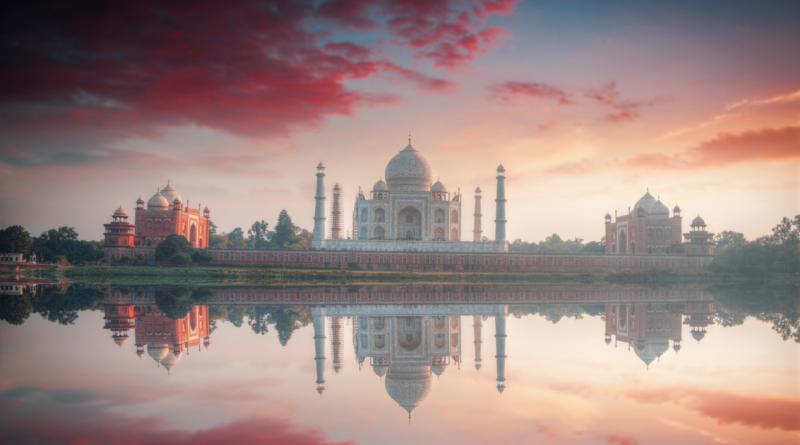17th June in History- Mughal Empress Mumtaz Mahal dies leading to the making of Taj Mahal
Mumtaz Mahal, the Mughal Empress, passed away on 17th June, 1631.
Empress Mumtaz Mahal, Shah Jahan’s cherished wife, dies while giving birth to their fourteenth child. Her grieving husband Emperor Shah Jahan took on a 21 year initiative to build the Taj Mahal, a domed marble mausoleum for his wife’s burial and one of the world’s architectural wonders, dedicating it to the memory of his beloved wife.

Mumtaz Mahal (Persian: ممتاز محل [mʊmˈt̪aːz mɛˈɦɛl], literally means, ‘the exalted one of the Palace‘), was the empress consort of the Mughal Empire from 19 January 1628 to 17 June 1631 as the principal consort of the Mughal monarch Shah Jahan. Her husband commissioned the Taj Mahal in Agra, which is generally referred to as one of the Seven Wonders of the World.
The Taj Mahal is not just one of India’s most popular tourist sites, but it is also the most well-known example of Mughal architecture, appearing on various lists of world marvels. It is sometimes referred to as “the world’s most famous mausoleum,” reflecting the pride and identity of Indian Muslims as an example of the achievements of Mughal rule, an era of progress and stability that is seen as a high point in India’s cultural history. The tomb is known as “Jewel of Muslim art“, according to UNESCO.
After more than two decades of construction, the mausoleum, which is taller than a modern 20-story structure, was completed in 1653. It was created in commemoration of Mumtaz Mahal, the Mughal emperor’s wife, who died in delivery in 1631. The Taj Mahal’s design combines Islamic, Turkish, Persian, and Indian architectural features. At different times of the day, the white marble of the structure takes on subtle variations in colour and tone. However, pollution has caused the white marble to yellow, so the Indian government has established the Taj Trapezium Zone, a 4,000-square-mile area around the structure with tight emission regulations.
The Taj Mahal was designated as a UNESCO World Heritage Site in 1983 and is located in the city of Agra, on the banks of the Yamuna River in the northern state of Uttar Pradesh.

Mumtaz Mahal was born, Arjumand Banu Begum to a Persian noble family in Agra. She was the niece of Empress Nur Jahan, Emperor Jahangir’s principal wife and the force behind the emperor, and the daughter of Abu’l-Hasan Asaf Khan, a wealthy Persian noble who held high status in the Mughal Empire. On 10 May 1612 or 16 June 1612, at the age of 19, she married Prince Khurram, afterwards known by his regnal name Shah Jahan, who bestowed the title “Mumtaz Mahal” on her (Persian: the exalted one of the palace).
Despite being betrothed to Shah Jahan since 1607, she married him in 1612. Mumtaz and her husband had 14 children, including Jahanara Begum (Shah Jahan’s favourite daughter) and Crown prince Dara Shikoh, the heir-apparent, who was temporarily ousted by Mumtaz Mahal’s sixth child, Aurangzeb, who eventually succeeded his father as the sixth Mughal emperor in 1658.
Mumtaz Mahal died in 1631 while giving birth to her 14th child, a daughter named Gauhar Ara Begum, at Burhanpur, Deccan (modern-day Madhya Pradesh).
The Taj Mahal, which is considered a symbol of unending love, was erected as a tomb for her by Shah Jahan.
No contemporary likenesses of her are recognized, as they are for other Mughal royal ladies, but countless imagined portraits of her have been constructed since the 19th century. She was incorrectly referred to as “Taj Bibi,” which was a distortion of her given name Mumtaz and was actually her mother-in-law’s title, ‘Jagat Gosain’. The Taj Mahal is not just one of India’s most popular tourist sites, but it is also the most well-known example of Mughal architecture, appearing on various lists of world marvels.
It is sometimes referred to as “the world’s most famous mausoleum,” reflecting the pride and identity of Indian Muslims as an example of the achievements of Mughal rule, an era of progress and stability that is seen as a high point in India’s cultural history. The tomb is known as ” Jewel of Muslim art” according to UNESCO.
After more than two decades of construction, the mausoleum, which is taller than a modern 20-story structure, was completed in 1653. It was created in commemoration of Mumtaz Mahal, the Mughal emperor’s wife, who died in delivery in 1631.
The Taj Mahal’s design combines Islamic, Turkish, Persian, and Indian architectural features.

At different times of the day, the white marble of the structure takes on subtle variations in colour and tone. However, pollution has caused the white marble to yellow, so the Indian government has established the Taj Trapezium Zone, a 4,000-square-mile area around the structure with tight emission regulations. The Taj Mahal was designated as a UNESCO World Heritage Site in 1983 and is located in the city of Agra, on the banks of the Yamuna River in the northern state of Uttar Pradesh.
source and reference: wikipedia




